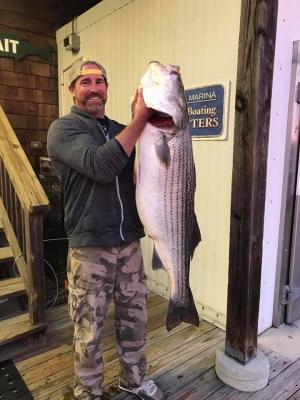On Monday, we had the first report of rockfish caught from the ocean along the Delaware coast. That day, the No Limit out of Indian River Marina caught a two-man limit of four rockfish trolling MOJOs two miles off Rehoboth. Out of Lewes, Jimmy Young had a 50-pound striper trolling Stretch plugs at Overfalls Shoal. Also with Jimmy were Matthew Anagnostakos, who caught a 35-pounder, and Ben Evick, who had a 27-pounder. The total for their day was 11 fish, with three over 44 inches. On another trip from Lewes, Jason Burris caught a 42-pound rockfish on a popper. His companions used swimming plugs as Matt Basile had a 36.5-pounder and Matt DiSabatino had a 36-pound striper.
Tog action was also good over ocean structure. Dave Walker caught a 10.5-pound tog at Site 11 and Joe Perseorelis had a 10-pounder. Of course, as soon as we get a few stripers in range of Delaware boats, the weather goes to the devil. The wind picked up to over 20 knots and the temperature dropped from the upper 60s to the low 40s. This weekend will be the coldest of the fall, but if the wind behaves itself, perhaps boats can get out and give the stripers a try. Please do not go out in less-than-ideal conditions. Things that happen in the summer and only cause a bit of trouble can be deadly once the water and air temperatures drop.
Fisheries law
It became apparent to me after reading some of the posts on social media concerning the menhaden issue that a good number of people have no idea how fisheries regulations are developed. Believe it or not, there is a system, and while it’s far from perfect, it has been helpful in conserving striped bass, red drum and to some extent, flounder.
The ocean is divided into two areas. From shore out three miles is considered state water, while any part of the ocean from the Three-Mile Limit out to 200 miles is federal water. Regulations for state waters are made by the Atlantic States Marine Fisheries Commission. In federal waters, the National Marine Fisheries Services make the regulations using several councils. The council that represents Delaware is the Mid-Atlantic Fishery Management Council with headquarters in Dover.
Both ASMFC and NMFS use the best scientific data available to base their regulations upon. In the case of menhaden, the current science from ASMFC showed overfishing was not occurring and the stock was not overfished. The idea of basing these regulations on the importance of menhaden in the ecological system, since they are a food source for several larger species, may be a good idea, but the science is not there to prove the case. The scientific community is working on developing this, but has not completed the work. Until then, the commission will continue to base the regulations on science, not popularity.
Summer flounder is another important fish for Delaware anglers. These fish are regulated by the National Marine Fisheries Services through the Mid-Atlantic Fishery Management Council. The council has been concerned because summer flounder have experienced poor reproduction for the past six years. In an attempt to conserve the breeding stock, the council has raised the minimum size and, in some states, it has shortened the season.
No one in the recreational fishing community was happy about this. Unfortunately, New Jersey decided to set its own regulations that it claimed had the same conservation equivalency as the federal regulations. The Mid-Atlantic Council did not agree and found New Jersey out of compliance. For the first time in the history of federal fishery management, the secretary of commerce overruled the council and allowed New Jersey to move ahead with its regulations. The full effect of this decision has yet to be felt.
In the past, states were allowed to select conservation equivalency regulations from a list provided by NMFS. In those days, anglers were asked to comment on the list, and the option that received the most votes was usually selected. That system was dropped when we went to regional management. Right now, Delaware is in the same region as Maryland and Virginia. With summer flounder, this makes good sense. Flounder spawn in the ocean, and the fry must make it back to the estuary where they will stay for a couple of years before moving out to the spawning stock. The adults keep moving north, so the largest summer flounder are found at the northernmost part of their range. New Jersey is in the same region as New York and Connecticut. New Jersey feels this is unfair, and that’s part of the reason why their representatives created their own regulations.
As you can see, fisheries regulations can be a bit complicated.























































